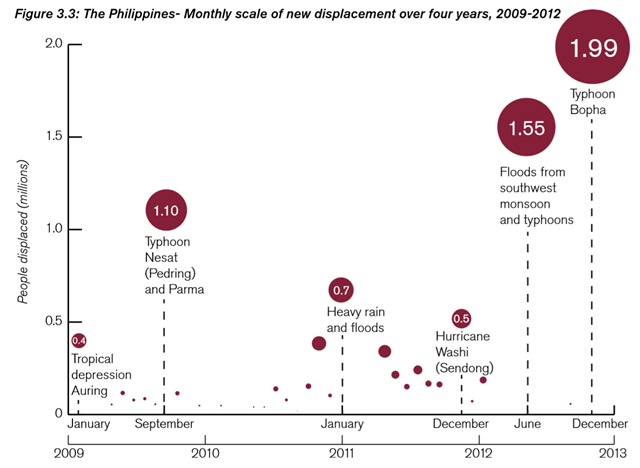Graph of the Day: Philippines internal displacement due to extreme weather events, 2009-2012
GENEVA, 13 MAY 2013 (IDMC) – In 2012, the Philippines had its highest level of disaster-induced displacement in five years. Some 3.9 million people were displaced. The Philippines is highly prone to frequent disasters and has recently had high levels of new displacement of at least one million people per annum. These high levels of displacement were made up of multiple events. Peak periods for new displacement over the past four years include around September 2009 when Typhoon Pepeng and another large flood event together displaced over 1.2 million people. Displacement peaked in June and December 2012 due to massive floods and the Typhoon Bopha disaster. Between June and September, severe and widespread flooding, strong winds, landslides, storm surges and flash floods displaced over 1.5 million people out of an affect- ed population of more than 4.4 million people (900,000 families). The impact of torrential and prolonged rain brought by the south-west monsoon was exacerbated by multiple typhoons – Saola (locally designated as Gener), Haikui, Kai-Tak, Tembin, and Bolaven – which added to repeated flooding and hampered recovery efforts.62 The government declared a state of calamity across regions of Luzon and in some parts of Mindanao and the Visayas. Local authorities reported around 70 per cent of Metro Manila affected by flooding, with floodwaters in some areas as deep as three metres, worsened by a high tide and the release of dam waters in surrounding provinces. Low-lying areas were flooded after the La Mesa reservoir was breached. Homes in shanty towns, including in Quezon City, were hit by landslides. The vast majority of IDPs took refuge with relatives and friends. In addition, hundreds of thousands of people were evacuated to emergency shelters. Local authorities expected prolonged displacement of people from areas where floodwaters are historically known to recede slowly. At the end of August, 1.2 million people were taking refuge with families or friends and 431 centres were still providing shelter to 135,000 people.
